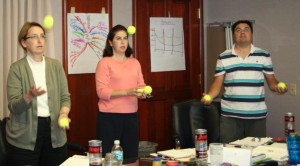Librarians Learn Idea Mapping
Uncategorized Tagged Idea Mapping, Idea Mapping Workshop, Mind Mapping No Comments »
Franklin Templeton librarians in Ft. Lauderdale attended a two-day Idea Mapping workshop to learn the benefits of the whole-brain approach to thinking, learning and planning. That was my very first workshop as a Certified Idea Mapping Instructor, and it was a lot of fun!
Idea Mapping, also known as Mind Mapping, is a whole-brain visual tool used by business people around the world to improve productivity, innovation and performance. Idea Mapping is based on discoveries made in neuroscience. It is effective because it mirrors how our brains naturally process and associate information making meaningful connections between pieces of data. It creates synergy between right and left cortex skills integrating logic, lines, words, lists, numbers, and sequence with color and images. Using an idea map, thoughts and ideas can be effectively captured on a single sheet of paper making it easy to see and understand a big picture while still providing a way to include important details.
Using Idea Maps to Learn Faster
Idea maps can be used to accelerate learning and get new employees up to speed faster. Miroslava Litwak, who joined the library a few months ago as Digital Services Analyst, is using idea maps to learn about investment concepts behind charts and graphs she creates for the library clients. Her map of the David Dreman’s book “Contrarian Investment Strategies” demonstrates key principles behind idea mapping such as using key words, images and color.
As you can see, creation of a map begins in the center with a main topic as a key word or an image. Branches that represent key information related to the topic radiate from the main topic and spread clockwise throughout the page so that key ideas can be seen instantly. Color, images and symbols activate creative areas of the right brain adding more fun to the thinking process and improving information recall.


![[blinklist]](http://powermapping.ideamappingsuccess.com/IdeaMappingBlogs/wp-content/plugins/bookmarkify/blinklist.png)
![[BlogMarks]](http://powermapping.ideamappingsuccess.com/IdeaMappingBlogs/wp-content/plugins/bookmarkify/blogmarks.png)
![[Blogsvine]](http://powermapping.ideamappingsuccess.com/IdeaMappingBlogs/wp-content/plugins/bookmarkify/blogsvine.png)
![[del.icio.us]](http://powermapping.ideamappingsuccess.com/IdeaMappingBlogs/wp-content/plugins/bookmarkify/delicious.png)
![[Digg]](http://powermapping.ideamappingsuccess.com/IdeaMappingBlogs/wp-content/plugins/bookmarkify/digg.png)
![[diigo]](http://powermapping.ideamappingsuccess.com/IdeaMappingBlogs/wp-content/plugins/bookmarkify/diigo.png)
![[Facebook]](http://powermapping.ideamappingsuccess.com/IdeaMappingBlogs/wp-content/plugins/bookmarkify/facebook.png)
![[Jeqq]](http://powermapping.ideamappingsuccess.com/IdeaMappingBlogs/wp-content/plugins/bookmarkify/jeqq.png)
![[Ma.gnolia]](http://powermapping.ideamappingsuccess.com/IdeaMappingBlogs/wp-content/plugins/bookmarkify/magnolia.png)
![[Mister Wong]](http://powermapping.ideamappingsuccess.com/IdeaMappingBlogs/wp-content/plugins/bookmarkify/misterwong.png)
![[Netvouz]](http://powermapping.ideamappingsuccess.com/IdeaMappingBlogs/wp-content/plugins/bookmarkify/netvouz.png)
![[Newsvine]](http://powermapping.ideamappingsuccess.com/IdeaMappingBlogs/wp-content/plugins/bookmarkify/newsvine.png)
![[Propeller]](http://powermapping.ideamappingsuccess.com/IdeaMappingBlogs/wp-content/plugins/bookmarkify/propeller.png)
![[Reddit]](http://powermapping.ideamappingsuccess.com/IdeaMappingBlogs/wp-content/plugins/bookmarkify/reddit.png)
![[Slashdot]](http://powermapping.ideamappingsuccess.com/IdeaMappingBlogs/wp-content/plugins/bookmarkify/slashdot.png)
![[Sphinn]](http://powermapping.ideamappingsuccess.com/IdeaMappingBlogs/wp-content/plugins/bookmarkify/sphinn.png)
![[StumbleUpon]](http://powermapping.ideamappingsuccess.com/IdeaMappingBlogs/wp-content/plugins/bookmarkify/stumbleupon.png)
![[Technorati]](http://powermapping.ideamappingsuccess.com/IdeaMappingBlogs/wp-content/plugins/bookmarkify/technorati.png)
![[Twitter]](http://powermapping.ideamappingsuccess.com/IdeaMappingBlogs/wp-content/plugins/bookmarkify/twitter.png)
![[Email]](http://powermapping.ideamappingsuccess.com/IdeaMappingBlogs/wp-content/plugins/bookmarkify/email.png)